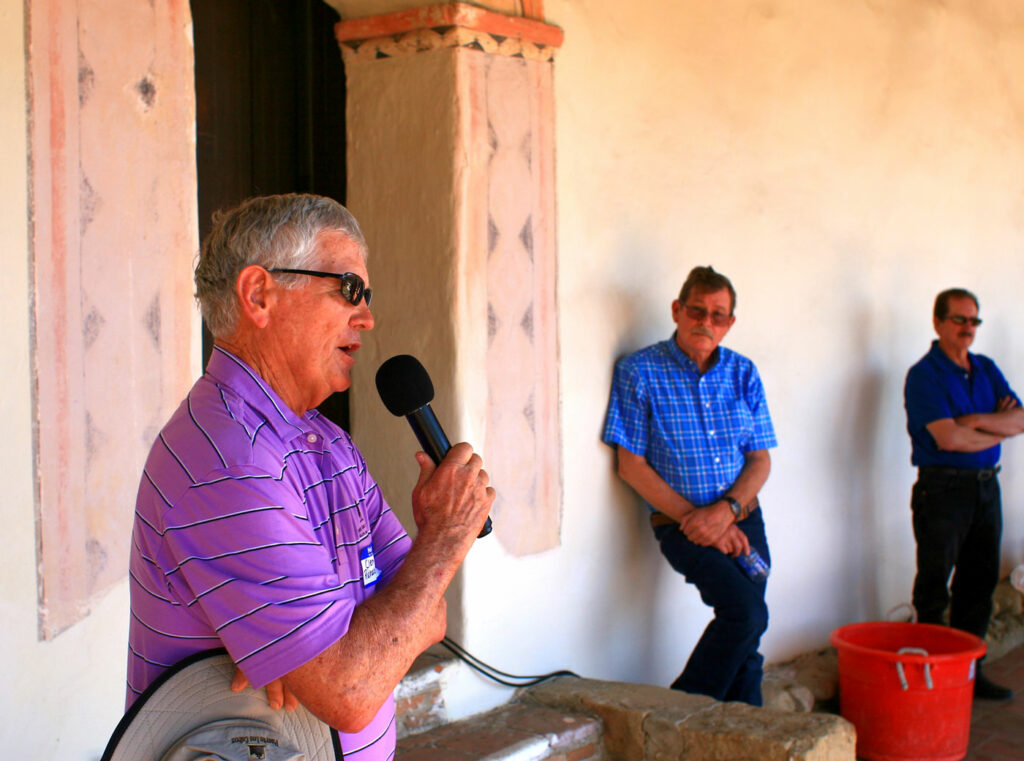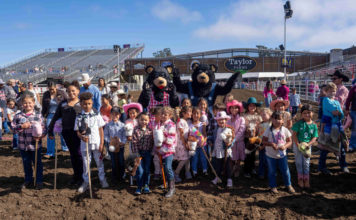
JOLON — The Campaign for the Preservation of Mission San Antonio de Padua hosted a celebration event last Sunday to mark the completion of earthquake retrofitting.
Hundreds attended the April 3 celebration and luncheon, which was followed up by a tour of the mission — located near Jolon in South Monterey County — and discussion of the changes made since 2014.
Mission Administrator Joan Steele explained seismic work stopped in 2018 for budgetary reasons, but the Covid-19 pandemic didn’t stop construction. During the past two years, though the mission was closed to the public, essential restoration work was able to continue.
“The church now has 214 vertical cores, which have steel beams in them,” Steele said.
A total of $12 million was spent on the seismic retrofit and the other upgrades around the mission. The largest part of the project was the actual retrofitting, which involved removing the roof and drilling holes into the walls to add epoxy and steel, resulting in a skeleton that will change how the structure moves in an earthquake.
“Originally, the roof and walls were separate when built, and in an earthquake they would move separately,” Steele explained. “Now, there is a steel skeleton that ties it all together, so if there was a strong enough earthquake, the building would move together.”
Upgrading the utilities
Changes to utilities also took place during the revamp.
“Even though they had done really good electrical work in the 1940s, it was never meant to carry the load we have today,” Steele said about the upgrade to the electrical system.
Plumbing was upgraded in all rooms, along with adding smoke detection systems. To become ADA compliant, more safety features were added and additional bathrooms and ramps were made, such as in the dining room area, which had a window removed to add a second doorway and ramp.
Upgrades to the local water utilities resulted in other future upgrades. The mission began upgrades to its sewer lines in late March.
“We didn’t have any problems with the sewer system until we did the retrofit,” Steele said. “Once we did the retrofit, the county mandated that we use low-flow toilets. All of a sudden, every retreat I’m calling the plumber at seven in the morning.”
It was discovered the repeated blocks with low-flow water use were the result of 80-year-old sewer lines disintegrating. Thus, a $316,000 project was started to replace the sewer lines.
The fiesta grounds lost many of the little buildings due to not being up to code. The pavilion roof was starting to cave in, so the area is closed to the public pending repair. That might cause changes to the Fiesta Day event typically held in June.
“We don’t know if there will be a fiesta this year, and if there is, it likely won’t be in the fiesta grounds,” Steele said.
Attendees at Sunday’s celebration were introduced to the new board members who will oversee ongoing repair and maintenance projects. Those members were President Michael Lugo, Vice President David Mascorro, Treasurer Jessica Rodgers, Secretary Lawrence Wise and board members Clancy D’Angelo, Duane Wolgamott and Steele.
The foundation was formed in 2010 as a separate entity from the parish as a secular fundraising group, with funds only going toward restoration and preservation, and none going to the Catholic church or even the costs of running the mission.

A change in color
Guests who have visited the mission in decades past will notice a change to the coloration at the mission, with the peach-colored walls now white.
“You’re not supposed to paint adobe,” Steele said. “Adobe can’t breathe if it’s painted. They had to take the paint off and re-limewash it. The limewashing needs to be done every five to 10 years, so it’s a continual process to keep up with it. It’s hard to keep adobe looking new.”
Though people may think the peach color is historic, Steele explained the walls were painted peach in the 1970s.
Other anachronisms added to the mission over the centuries either endure or have been altered.
Steele explained the mission’s church was originally designed for 1,300 people to stand inside. That meant the original mission didn’t have pews. Though the pews remain for a church with a modern capacity of 300.
The original five statues are in their original locations, and are the historic statues made in Mexico from wood and polished to look like porcelain. One change, however, was discovered while restoring the statue of Joseph.
“When Joseph was sent out to be cleaned, he was wearing brown robes and when he came back, he had these beautiful Oriental-looking robes,” Steele said. “We think somewhere along the way the Franciscans thought he didn’t look humble enough and they overpainted the gold with brown paint.”
Restoration workers discovered the overpainting and removed it to restore Joseph to a much brighter outfit.
One change of time that was kept was the water staining on the roof in the church. Steele said the stains, though a sign of water problems, became part of the historical look of the mission, and were maintained in the restoration.
Growing a new garden
The garden was the last update made, and Steele said the entire garden was gutted. A total of 70 of the 300 historic rose plants in the garden were saved and replanted, with the public made aware of the opportunity to dig up plants to take home for themselves to preserve the plants.
Steele added that the board wanted to represent Salinan history in the garden, and consulted with board treasurer Jessica Rodgers, herself a Salinan descendant, to identify plants used by Salinans. Of the 30 plants she identified, 27 were added to the garden.
“It is in honor of the Salinan people that built this mission that we did the garden the way we did,” she said.
There was some public concern over the reset of the garden, with Steele noting one recent letter as being irate over the destruction of what the writer felt was a historic garden.
“If it were to be truly historic, it would be dirt,” she said. “That was not a garden and was never meant to be a garden. It was a work area. It was meant to be dirt and had a well, and that’s it. They brought the small animals in there at night to keep them away from predators.”
The area became a garden in the past century due to the desires of retreat guests and brides who wanted to see a vibrant setting. While the garden itself has been drastically changed, the idea of a garden remains.
“Gardens change over time and they have to serve the population that’s using them,” Steele said.
In addition to the garden adding Salinan representation, Steele said the first room in the museum was dedicated to the history of that tribe. Cases of artifacts sit below a new 20-foot-long mural depicting the pre-Franciscan setting of the Salinan people.
Steele explained that it was important to the board to have representation of the people involved in the history of the mission, from the garden and museum, to two of the board members being of Salinan descent.
“It’s important to tell history and tell it authentically, both the good and bad things that happened at the mission,” she said.
The new efforts by the board include sewer upgrades and repair to the pavilion, as well as a 50-year plan to collect $9 million for ongoing maintenance.
“What happened is they restored it in 1948, then they didn’t do anything to it after that,” Steele said. “We don’t ever want it to go back down, and we have to keep it maintained.”
The new board will work toward raising funds over a 50-year timeline. Those interested in contributing can send donations to P.O. Box 450, King City, CA 93930, or via the campaign website preservemissionsanantonio.org.














